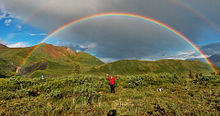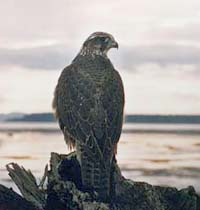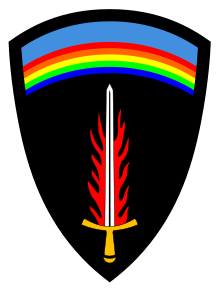Symbols
Appearance
(Redirected from Emblems)

Symbols are things such as particular forms or marks which represent some sort of information, an idea, a physical entity or a process but is distinct from it. The purpose of a symbol is to communicate meaning and they often are derived from or are used in metaphors. Studies of how symbols are used are a major aspect of the discipline of semiotics.
Quotes
[edit]
To hang in the future sky... ~ Robinson Jeffers

The sword: an obsolete instrument of bronze or steel,
formerly used to kill men, but here
In the sense of a symbol. ~ Robinson Jeffers

Run parallel to reality, they symbolize it, they squint at it,
They never touch it... ~ Robinson Jeffers


- We Indians live in a world of symbols and images where the spiritual and the commonplace are one. To you symbols are just words, spoken or written in a book. To us they are part of nature, part of ourselves, even little insects like ants and grasshoppers. We try to understand them not with the head but with the heart, and we need no more than a hint to give us the meaning.
- Paula Gunn Allen, The Sacred Hoop: Recovering the Feminine in American Indian Traditions. Beacon Press. 1 September 1992. ISBN 978-0-8070-4617-3. Chapter Two
- In a sense, the American Indian perceives all that exists as symbolic. This outlook has given currency to the concept of the Indian as one who is close to the earth, but the closeness is actual, not a quaint result of savagism or childlike naiveté. An Indian, at the deepest level of being, assumes that the earth is alive in the same sense that human beings are alive. This aliveness is seen in nonphysical terms, in terms that are perhaps familiar to the mystic or the psychic, and this view gives rise to a metaphysical sense of reality that is an ineradicable part of Indian awareness. In brief, we can say that the sun or the earth or a tree is a symbol of an extraordinary truth.
- Paula Gunn Allen, The Sacred Hoop: Recovering the Feminine in American Indian Traditions. Beacon Press. 1 September 1992. ISBN 978-0-8070-4617-3. Chapter Two
- Symbols in American Indian systems are not symbolic in the usual sense of the word. The words articulate reality—not “psychological” or imagined reality, not emotive reality captured metaphorically in an attempt to fuse thought and feeling, but that reality where thought and feeling are one, where objective and subjective are one, where speaker and listener are one, where sound and sense are one.
- Paula Gunn Allen, The Sacred Hoop: Recovering the Feminine in American Indian Traditions. Beacon Press. 1 September 1992. ISBN 978-0-8070-4617-3. Chapter Two
- The symbol is the tool which gives man his power, and it is the same tool whether the symbols are images or words, mathematical signs or mesons.
- Jacob Bronowski, "The Reach of Imagination" (1967)
- [S]ymbols have a reach and a roundness that goes beyond their literal and practical meaning. They are the rich concepts under which the mind gathers many particulars into one name, and many instances into one general induction.
- Jacob Bronowski, "The Reach of Imagination" (1967)
- King Arthur had a dream, too. Of a world where might served right, instead of subjugating it. His knights of the Round Table were the agents of that dream … and his sword, Excalibur, the Symbol of it. He died, the table was destroyed, his knights mostly slain — yet the dream survived. They became legend — and the sword, the means of keeping the legend alive and vital through the ages. … The sword Excalibur, represented Hope. It was light in the darkness of fear and ignorance and hate. Do we want — have we the right — to snuff it out?
- Chris Claremont, in Excalibur : The Sword is Drawn (1987), Rachel Summers (Phoenix) to the other mutants, p. 46 - 47.
- We are symbols, and inhabit symbols.
- Ralph Waldo Emerson, "The Poet", in Essays: Second Series (1844); Complete Works, Volume III (Boston and New York: Houghton, Mifflin and Company, 1904), p. 20.
- We often dismiss controversies or concerns by waving our hands and saying something like, “Oh, that’s merely symbolic,” as if the meaning we give to symbols is somehow irrelevant compared with more tangible things. But symbolism — the way we reduce broad concerns, agendas, and visions to images or rituals — has played a defining role in human life since there have been humans. Try burning a flag or a cross in front of the wrong audience and then tell me symbolism is nothing.
- Jonah Goldberg, "The Border Wall Is a Symbol of Our Symbolic Politics" (28 December 2018), National Review
- I think, here is your emblem
To hang in the future sky;
Not the cross, not the hive,
But this; bright power, dark peace;
Fierce consciousness joined with final
Disinterestedness;
Life with calm death; the falcon’s
Realist eyes and act
Married to the massive
Mysticism of stone,
Which failure cannot cast down
Nor success make proud.- Robinson Jeffers, in "Rock and Hawk" in Solstice and Other Poems (1935).
- Reason will not decide at last; the sword will decide.
The sword: an obsolete instrument of bronze or steel,
formerly used to kill men, but here
In the sense of a symbol.- Robinson Jeffers, in "Contemplation of The Sword" (1938).
- Science and mathematics
Run parallel to reality, they symbolize it, they squint at it,
They never touch it: consider what an explosion
Would rock the bones of men into little white fragments and unsky the world
If any mind for a moment touch truth.- Robinson Jeffers, in "The Silent Shepherds" (1958).
- In fact a man in love or one consumed with hatred creates symbols for himself, as a superstitious man does, from a passion of conferring uniqueness on things or persons. A man who knows nothing of symbols is one of Dante's sluggards. This is why art mirrors itself in primitive rites or strong passions, seeking for symbols, revolving round the primitive taste for savagery, for what is irrational (blood and sex).
- Cesare Pavese, This Business of Living, 1944-07-14
- All religious expression is symbolism; since we can describe only what we see, and the true objects of religion are The Seen. The earliest instruments of education were symbols; and they and all other religious forms differed and still differ according to external circumstances and imagery, and according to differences of knowledge and mental cultivation. All language is symbolic, so far as it is applied to mental and spiritual phenomena and action. All words have, primarily, a material sense, howsoever they may afterward get, for the ignorant, a spiritual non-sense. To "retract," for example, is to draw back, and when applied to a statement, is symbolic, as much so as a picture of an arm drawn back, to express the same thing, would he. The very word "spirit" means " breath," from the Latin verb spiro, breathe.
- Albert Pike, Morals and Dogma of the Ancient and Accepted Scottish Rite of Freemasonry (1871), Ch. III : The Master, p. 62.
- It is not in the books of the Philosophers, but in the religious symbolism of the Ancients, that we must look for the footprints of Science, and re-discover the Mysteries of Knowledge.
- Albert Pike, Morals and Dogma of the Ancient and Accepted Scottish Rite of Freemasonry (1871), Ch. XXXII : Sublime Prince of the Royal Secret.
- Promethea: Don't worry, some symbols always means the same thing...and the archetype of wisdom is eternal.
- Alan Moore Promethea The Judgement of Solomon
- Art is the symbol of the two noblest human efforts: to construct and to refrain from destruction.
- Simone Weil, The Pre-War Notebook (1933-1939), published in First and Last Notebooks (1970) edited by Richard Rees.
- Concern for the symbol has completely disappeared from our science. And yet, if one were to give oneself the trouble, one could easily find, in certain parts at least of contemporary mathematics... symbols as clear, as beautiful, and as full of spiritual meaning as that of the circle and mediation. From modern thought to ancient wisdom the path would be short and direct, if one cared to take it.
- Simone Weil, The Need for Roots (1949) p. 292.
- In a book called Symbolism, Its Meaning and Effect, Whitehead points out that perception is usually a matter of symbols, just like language; I say I see a book when I actually see a red oblong. The Transactionists (who have been influenced by Whitehead rather than Husserl) take this one stage further, and point out that when I 'perceive' something, I am actually making a bet with myself that what I perceive is what I think it is. In order to act and live at all, I have to make these bets; I cannot afford to make absolutely certain that things are what I think they are. But this means that we should not take our perceptions at face value, any more than Nietzsche was willing to take philosophy at its face value; we must allow for prejudice and distortion.
- Colin Wilson in Introduction to the New Existentialism, p. 66 (1966)
Hoyt's New Cyclopedia Of Practical Quotations
[edit]- Quotes reported in Hoyt's New Cyclopedia Of Practical Quotations (1922), p. 775.
- With crosses, relics, crucifixes,
Beads, pictures, rosaries, and pixes;
The tools of working out salvation
By mere mechanic operation.- Samuel Butler, Hudibras, Part III (1678), Canto I, line 1,495.
- It [Catholicism] supplies a multitude of external forms in which the spiritual may be clothed and manifested.
- Nathaniel Hawthorne, Marble Faun, Volume II, Chapter XIII.
- All things are symbols: the external shows
Of Nature have their image in the mind,
As flowers and fruits and falling of the leaves.- Henry Wadsworth Longfellow, The Harvest Moon.
- Sometime we see a cloud that's dragonish;
A vapour sometime like a bear or lion,
A tower'd citadel, a pendant rock,
A forked mountain, or blue promontory
With trees upon 't, that nod unto the world,
And mock our eyes with air: thou hast seen these signs;
They are black vesper's pageants.- William Shakespeare, Antony and Cleopatra (1600s), Act IV, Stanza 14, line 2.
- If he be not in love with some woman, there is no believing old signs: a' brushes his hat o' mornings; what should that bode?
- William Shakespeare, Much Ado About Nothing (1598-99), Act III, scene 2, line 40.



